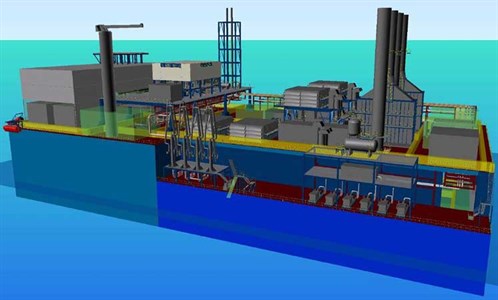DNV GL grants approval in principle for new IHI floating power generation concept

A 3D model of the concept. Graphic courtesy of DNV GL.
The concept behind the floating LNG power station (FLPS) is a combination of a floating storage and regasification unit (FSRU) and a power plant. It is expected to be installed in locations where alternative onshore infrastructure is not feasible or commercially viable, while energy demand is rapidly increasing. The FLPS solution is also in line with the worldwide trend for decentralized power generation.
It provides the opportunity for the receiving location to take advantage of the availability of natural gas as part of their power mix.
The main functions of the FLPS are LNG loading from a visiting LNG carrier, regasification of the LNG, power generation using natural gas and export of electricity to an onshore grid. The FLPS is designed to be capable of remaining on location for up to 25 years without dry-docking.
The FLPS concept considered uses a single point mooring tower yoke for position keeping, if the jetty meeting the draft requirement for both LNG carrier and FLPS is not available.
Regasification takes place in the topside facility located on the deck of the FLPS and the gas is then fed to the power generation system, which uses an energy-efficient combined cycle consisting of gas turbines with heat recovery steam generators and steam turbine. The power is supplied to the onshore electricity grid by high voltage subsea power cables.
The FLPS concept has been developed based on IHI’s long experience with onshore LNG receiving terminals and LNG containment systems. After carrying out studies of the design, DNV GL has been able to issue an approval in principle for the concept.

- ExxonMobil halts 1-Bft3d blue hydrogen project in Texas
- Aramco and Yokogawa commission multiple autonomous control AI agents at Fadhili gas plant
- Ukraine will resume gas imports via Transbalkan route in November
- Mitsubishi to inject $260 MM into Brunei LNG project
- Freeport LNG (U.S.) on track to take in more natgas on Thursday after unit outage



Comments